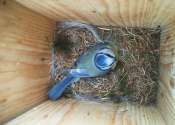Male (♂) refers to the sex of an organism, or part of an organism, which produces small mobile gametes, called spermatozoa. Each spermatozoon can fuse with a larger female gamete or ovum, in the process of fertilization. A male cannot reproduce sexually without access to at least one ovum from a female, but some organisms can reproduce both sexually and asexually.
Not all species share a common sex-determination system. In humans and most animals, sex is determined genetically but in other species it can be determined due to social, environmental, or other factors. The existence of two sexes seems to have been selected independently across different evolutionary lineages (see Convergent Evolution). Accordingly, sex is defined operationally across species by the type of gametes produced (ie: spermatozoa vs. ova) and differences between males and females in one lineage are not always predictive of differences in another.
Male/Female dimorphism between organisms or reproductive organs of different sexes is not limited to animals; male gametes are produced by chytrids, diatoms and land plants, among others. In land plants, female and male designate not only the female and male gamete-producing organisms and structures but also the structures of the sporophytes that give rise to male and female plants.








